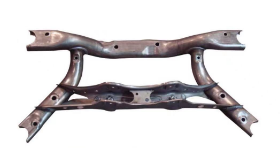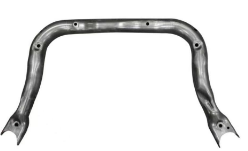Introduction

Roll forming is a metal forming process that involves passing metal strip or sheet through a series of rollers that gradually bend the metal and form it into a specific shape or profile. Rollers are designed to apply precise pressure and bend metal in a consistent and repeatable manner. Roll forming can be used to produce a wide variety of shapes and profiles, from simple angles and channels to complex panels and tubes.
Advantage
Roll forming offers several advantages over other metal forming methods such as stamping, bending and welding. These advantages include:
High Productivity: Roll forming is a continuous process that can produce long gauge metal profiles quickly and efficiently while minimizing material waste.
Cost-effective: Roll forming can produce complex shapes and profiles with minimal secondary operations such as cutting, punching and drilling, reducing production costs.
Accuracy and Repeatability: Roll forming can produce parts with high precision, high consistency, tight tolerances and low deformation.
Increased Strength: Roll forming can increase the strength and stiffness of metals by controlling the grain structure and reducing material thickness.
Versatility: Roll forming can produce a wide variety of shapes and profiles, from simple angles and channels to complex panels and tubing, for a variety of industries and applications.
Application
Roll forming is used in a wide variety of industries including automotive, construction, HVAC and furniture. Some examples of roll formed parts include:
Automotive components: Roll forming is used to produce a variety of automotive components such as bumper beams, door frames and seat tracks.
Construction materials: Roll forming is used to produce a variety of construction materials such as roof panels, wall panels and gutters.
HVAC Components: Roll forming is used to produce a variety of HVAC components such as ductwork, diffusers and grilles.
Furniture components: Roll forming is used to produce various furniture components such as chair frames, table legs and shelves.
Product


Part: Rear Subframe
Material:CrossBeam:QStE340TM2.7mm
Stringer Beam: QStE340TM 2.5mm
Part: Front Subframe
Material:S315MC 2.5mm
The material covers from mild steel to ultra-high strength steel, especially suitable for high strength steel plate, such as cold steel
Rolling and galvanizing: HC700/900MS HC700/980MS
HC950/1180MS HC1030/1300MS HC1200/1500MS
HC1350/1700MS HC420/780DP HC420/780DPD+Z
HC550/980DPHC550/980DPD+Z HC820/1180DP
HC820/1180DPD+Z
Hot rolling: OStE550TM OStE600TM OStE650TM
OStE700TM B600L B650L B700L B750L S650MC
S700MC
Roll forming is a versatile and cost-effective metal forming process that offers several advantages over traditional metal forming methods, including high productivity, precision and repeatability, increased strength and versatility. Its use in various industries continues to grow as more companies seek to produce complex and long metal shapes with a minimum of material waste and secondary operations.

